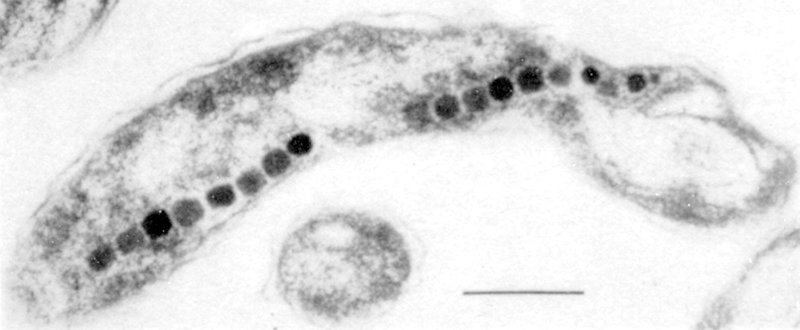| Objective
The aim of this research is
the discovery of a particular structure at he acupuncture points.
This structure is of a metallic nature in the shape of magnetozomes or
magnetite crystals (Fe3O4). The metallic bits found at the acupuncture
points would be part of the Mendeleiev transition period i.e : V.Cr.Mn.Fe.Co.Ni.Cu.
The size of the magnetozomes can be compared to the size of viruses, i.e
500 Angström cubic. In 1975 Richard Blackmore , an American microbiologist
of the Newhampshire University discovered in brackish water sediments
bacteria moving in accordance with the magnetic field in order to feed.
These bacteria were described as being magnetotactic in the same way as
other beings are phototactic because they use luminous sources to find
their way.
 |
|
Magnetotactic bacteria
Black spot = 500 Angström cube=>Every spot is a two poles
magnet
(photo : Richard Blackmore 1975) |
The
magnetozome.
Each bacterium has one or several cubic shaped particles sizing 500 Angström
and has a North pole and a South pole like the needle of the compass.
These magnetozomes are placed
in a line which is parallel to the bacteria’ s axis of mobility.
They then produce a “Magnetic Dipole” which is great enough
to allow the bacteria to move alongside the local magnetic field.The aim
of this research is the discovery of a particular structure at he acupuncture
points.
This structure is of a metallic nature in the shape of magnetozomes or
magnetite crystals (Fe3O4). The metallic bits found at the acupuncture
points would be part of the Mendeleiev transition period i.e : V.Cr.Mn.Fe.Co.Ni.Cu..
The size of the magnetozomes can be compared to the size of viruses, i.e
500 Angström cubic. In 1975 Richard Blackmore , an American microbiologist
of the Newhampshire University discovered in brackish water sediments
bacteria moving in accordance with the magnetic field in order to feed.
These bacteria were described as being magnetotactic in the same way as
other beings are phototactic because they use luminous sources to find
their way. Each bacterium has one or several cubic shaped particles sizing
500 Angström and has a North pole and a South pole like the needle
of the compass.
These magnetozomes are placed
in a line which is parallel to the bacteria’ s axis of mobility.
They then produce a “Magnetic Dipole” which is great enough
to allow the bacteria to move alongside the local magnetic field.
The research
Assessment
To ensure our credibility within our colleagues
and patients, the discovery of a particular structure at the acupuncture
point has always been paramount for us Acupuncturist Doctors.
Electricity and Acupuncture are tightly linked and the discovery in 1952
by Doctor Niboyet of the slightest electrical resistance of the acupuncture
point can be explained by the presence of metallic elements inside the
dermis. This fundamental discovery was followed by the conception and
common use of acupuncture point detectors and external electro-stimulators.
A metallic structure can be revealed using the PERLS colour solution ,
used for the preparation of the histological sections when investigating
metals. Numerous researches about the acupuncture point have published,
whether in optic microscopy or electronic microscopy. However none of
the publications ever mentioned the use of a particular colouring. The
research about the concentration of magnetozomes at the acupuncture points
has never yet been undertaken, and to this day, there is not any publication
anywhere in the world about it.
However many things have been printed about the magnetozomes , in many
different living species such as bacteria, bees, pigeons, tuna- fish,
dolphins, sea turtles etc. (La Recherche n°14- February 1983), in
which the publications aim mostly at defining this particular structure
which enables living organisms to find their way in time and space.
As regarding the human being, the discovery
of magnetite crystals in the arch of the eyebrows, has been mentioned
by Robin Baker in England (La Recherche- January 1984). J. Kirschvink
in Princeton was able to quantify in the human tissues of the suprarenal
glands a high magnetic moment only possible because of a high magnetite
concentration. In his book, “la science et les sourciers”,
French Professor Yves Rocard reckons to have found the “magnetic
organs” of the human body. They would be located in the arch of
the eyebrows, the neck muscles, on the skull, in the nape of the neck,
in the inside of the elbows and knees, and on the heels.
|

